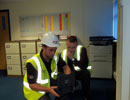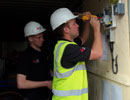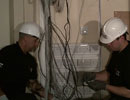- Immediate Response
- Electricians Available 24/7
- Niceic Electrician Services
Niceic Electrician Salford
Domestic & Commercial Electrician Services In Salford
Niceic Electrician Salford - Professional Electricians
0161-627-2666

Electrician Salford
![]() Salford and it's local history.
Salford and it's local history.
Salford - Geography & history
Salford began to emerge as a small town early in the 13th century. In 1228, Henry III granted the caput of Salford the right to hold a market and an annual fair. The fairs were important to the town; a 17th-century order forced each burgess – a freeman of the borough – to attend, but the fairs were abolished during the 19th century. The name of Salford derives from the Old English word Sealhford, meaning a ford by the willow trees.
 |
 |
 |
 |
looking for an Electrician in Salford, Salford ?
Electrical Testing Salford ?
Our Niceic electricians carry out a full range of Niceic tests & insepctions
Electrical Fault Salford ?
Our electricians are all fully trained in fault diagnosis
New Electrical Installation Salford ?
Our Niceic Electricians will work with your builders from design to implementation
Fitting a Kitchen or Shower Salford ?
Our Professional Niceic electricians can give you a free quotation.
Outside Lighting or Power Salford ?
Our Niceic electricians can help your plan the most cost effective options.
Salford (pronounced /ˈsɔːlfərd/) lies at the heart of the City of Salford, a metropolitan borough of Greater Manchester, in North West England. Salford is sited in a meander of the River Irwell, which forms its boundary with the city of Manchester to the east. Together with its neighbouring towns to the west, Salford forms the local government district of the City of Salford, which is administered from Swinton. The former Borough of Salford, which included Broughton, Pendleton, and Kersal, was granted honorific city status in 1926; it has a resident population of 72,750 and occupies an area of 8.1 square miles (21 km2). The wider City of Salford district has a population of 219,200.
Historically a part of Lancashire, Salford's early history is marked by its status as a Royal caput and the judicial seat of the ancient hundred of Salfordshire, to which it lent its name. It was granted a charter by Ranulf de Blondeville, 6th Earl of Chester, in about 1230, making Salford a free borough. During the early stages of its growth, Salford was of greater cultural and commercial importance than its neighbour Manchester, although most contemporary sources agree that since the Industrial Revolution of the late-18th and early-19th century that position has been reversed.
Salford became a major factory town and inland port during the 18th and 19th centuries. Cotton and silk spinning and weaving in local mills attracted an influx of families and provided Salford with a strong economy. Salford Docks was a principal dockyard of the Manchester Ship Canal. By the end of the 19th century Salford had an enlarged working class community and suffered from chronic overpopulation.
Industrial activities declined during the 20th century however, causing a local economic depression. Salford subsequently became one of contrasts, with regenerated inner-city areas like Salford Quays next to some of the most socially deprived and violent areas in England.
Salford has become a centre of higher education, home to the University of Salford, and has seen several firsts, including the world's first unconditionally free public library, and the first street in the world to be lit by gas, Chapel Street in 1806. Salford is set to become the headquarters of CBBC and BBC Sport in 2011.
Toponymy
The name of Salford derives from the Old English word Sealhford, meaning a ford by the willow trees. It referred to the willows (Latin: salix) or sallows that grew alongside the banks of the River Irwell. The ford was about where Victoria Bridge is today. Willow trees are still found in Lower Broughton.[10] Salford appears in the pipe roll of 1169 as "Sauford" and in the Lancashire Inquisitions of 1226 as "Sainford".
Salford history
The earliest known evidence of human activity in what is now Salford is provided by the Neolithic flint arrow-heads and workings discovered on Kersal Moor and the River Irwell, suggesting that that the area was inhabited 7–10,000 years ago. The raw material for such tools was scarce and unsuitable for working, and as a result they are not of the quality found elsewhere. Other finds include a neolithic axe-hammer found near Mode Wheel, during the excavation of the Manchester Ship Canal in 1890, and a Bronze Age cremation urn during the construction of a road on the Broughton Hall estate in 1873.
The Brigantes were the major Celtic tribe in what is now northern England. With a stronghold at the sandstone outcrop on which Manchester Cathedral now stands, opposite Salford's original centre, their territory extended across the fertile lowland by the River Irwell that is now Salford and Stretford. Following the Roman conquest of Britain, General Agricola ordered the construction of a Roman fort named Mamucium (Manchester) to protect the routes to Deva Victrix (Chester) and Eboracum (York) from the Brigantes. The fort was completed in AD 79, and for over 300 years the Pax Romana brought peace to the area. Both the main Roman road to the north, from Mamucium to Ribchester, and a second road to the west, ran through what is now Salford, but few Roman artefacts have been found in the area. The withdrawal of the Romans in AD 410 left the inhabitants at the mercy of the Saxons. The Danes later conquered the area and absorbed what was left of the Brigantes. Angles settled in the region during the Early Middle Ages and gave the locality the name Sealhford, meaning "ford by the willows". According to the Anglo-Saxon Chronicle, Sealhford was part of the Kingdom of Northumbria until it was conquered in 923 by Edward the Elder.
Following the emergence of the united Kingdom of England, Salford became a caput or central manor within a broad rural area in part held by the Kings of England, including Edward the Confessor. The area between the rivers Mersey and Ribble was divided into six smaller districts, referred to as "wapentakes", or hundreds. The south east district became known as the Hundred of Salford, a division of land administered from Salford for military and judicial purposes. It contained nine large parishes, smaller parts of two others, and the township of Aspull in the parish of Wigan.
After the defeat of Edward the Confessor during the Norman conquest of England, William I granted the Hundred of Salford to Roger the Poitevin, and in the Domesday Book of 1086 the Hundred of Salford was recorded as covering an area of 350 square miles (906 km2) with a population of 35,000. Poitevin created the subordinate Manor of Manchester out of the hundred, which has since in local government been separate from Salford. Poitevin forfeited the manor in 1102 when he was defeated in a failed rebellion attempt against Henry I. In around 1115, for their support during the rebellion, Henry I placed the Hundred of Salford under the control of the Earldom of Lancaster, and it is from this exchange that the Hundred of Salford became a Royal Manor. The Lord of the Manor was either the English monarch, or a feudal land owner who administered the manor for the king. During the reign of Henry II the Royal Manor of Salford passed to Ranulf de Gernon, 4th Earl of Chester.
Salford began to emerge as a small town early in the 13th century. In 1228, Henry III granted the caput of Salford the right to hold a market and an annual fair. The fairs were important to the town; a 17th-century order forced each burgess – a freeman of the borough – to attend, but the fairs were abolished during the 19th century. The Earls of Chester aided the development of the caput, and in 1230 Ranulf de Blondeville, 6th Earl of Chester made Salford a burgage, or free borough. The charter gave its burgesses certain commercial rights, privileges, and advantages over traders living outside Salford; one of the 26 clauses of the charter stated that no one could work in the Hundred of Salford unless they also lived in the borough. Salford's status as a burgage encouraged an influx of distinguished families, and by the Late Middle Ages Salford was "rich in its manor houses", with over 30 within a 5-mile (8 km) radius of Ordsall. These included Ordsall Hall (owned by the Radclyffe family) and Broughton Hall, owned by the Earls of Derby.
During the English Civil War of 1640–49, Salford supported the Royalist cause, in contrast to Manchester just across the Irwell which declared in favour of the Parliamentarians. Royalist forces mounted a siege of Manchester across what is now the site of Victoria Bridge, which although short-lived, "did little to improve relations between the two towns". A century later, in 1745, Salford was staunchly in support of Bonnie Prince Charlie, in his attempt to seize the Throne of England. He entered the town at the head of his army and was blessed by the Reverend John Clayton before leaving "in high spirits" to march on London; he returned to Salford in defeat just nine days later.
Return to Niceic electrician Salford page
Salford - Niceic Electricians Salford.


